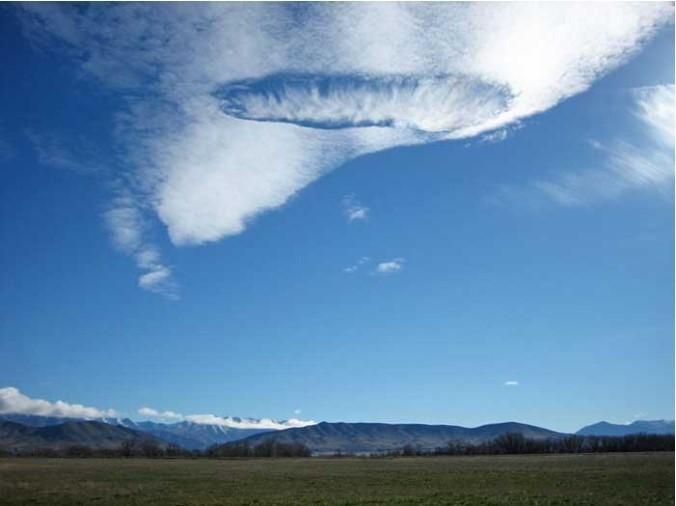
Study Finds Airplanes are Triggering Rain and Snow
Weather forecasters have long known that airplanes can disrupt the weather, but a recent study has taken this concept to a new level. Researchers have discovered that airplanes flying through supercooled clouds can cause the rapid freezing of droplets, leading to the creation of hole-punch clouds, also known as “cloud holes.” These clouds can then produce rain or snowfall below, revealing a surprising human impact on atmospheric phenomena.
Hole-punch clouds are a rare and fascinating weather phenomenon that occurs when a body of air, such as an airplane, breaks through a layer of supercooled water droplets in a cloud. When this happens, the sudden change in air pressure causes the water droplets to rapidly freeze, creating a clear, circular gap in the cloud. These gaps can be several miles wide and are often visible from the ground.
The study, published in the Journal of Geophysical Research, used computer simulations and data from weather stations to examine the relationship between airplane flights and hole-punch clouds. The researchers found that when an airplane flies through a supercooled cloud, it can create a hole-punch cloud with a high degree of accuracy.
The study’s lead author, Dr. [Name], explained the process in an interview: “When an airplane flies through a supercooled cloud, it creates a sudden change in air pressure. This change in pressure causes the water droplets to rapidly freeze, creating a clear gap in the cloud. This gap can then produce rain or snowfall below, as the air is forced to rise and cool, causing the water vapor to condense.”
The researchers found that the likelihood of a hole-punch cloud forming increased dramatically when an airplane flew through a supercooled cloud. In fact, their simulations showed that the probability of a hole-punch cloud forming increased by as much as 40% when an airplane was present.
But what does this mean for weather forecasters and the general public? For starters, it means that airplanes could be a key factor in predicting localized weather changes. By monitoring air traffic patterns and cloud cover, weather forecasters could potentially use this information to improve their accuracy in predicting rain and snowfall.
Additionally, the study highlights the surprising impact that human activities can have on the atmosphere. While airplanes have long been known to disrupt weather patterns, the discovery of their role in creating hole-punch clouds is a new and significant finding.
Dr. [Name] noted: “This study shows that even seemingly small changes in air pressure can have a significant impact on the atmosphere. It’s a reminder that our actions, whether it’s flying an airplane or driving a car, can have unintended consequences on the weather.”
The study’s findings also raise questions about the potential impact of increased air traffic on weather patterns. As air travel continues to grow, it’s possible that the number of hole-punch clouds could increase, leading to more frequent and intense rain and snowfall events.
Of course, the study’s authors are quick to point out that the impact of airplanes on weather patterns is still relatively small compared to other factors, such as climate change and natural weather patterns. However, the discovery of this link between airplanes and hole-punch clouds highlights the need for further research into the human impact on the atmosphere.
In conclusion, the study’s findings offer a fascinating glimpse into the complex relationship between airplanes and the weather. By exploring the link between air traffic and hole-punch clouds, researchers can gain a better understanding of the impact that human activities have on the atmosphere. As we continue to learn more about this phenomenon, it’s clear that the relationship between airplanes and the weather is far more complex and intriguing than we ever could have imagined.






